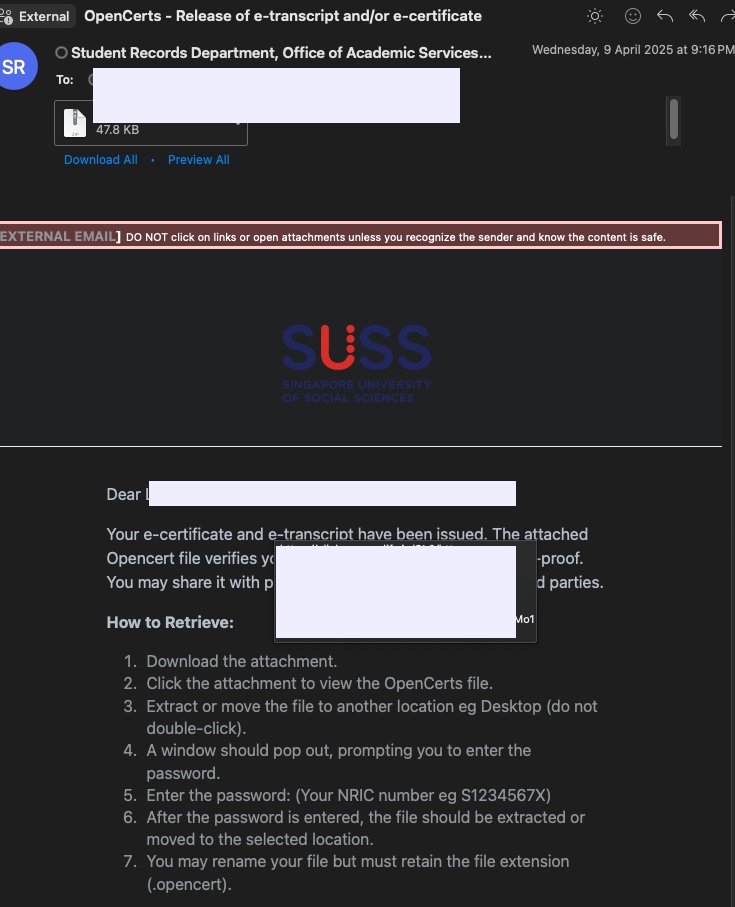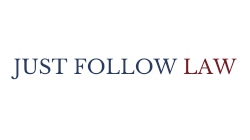Finally! I am done (hopefully) with studying!
In 2021 I embarked on pursuing a law degree with the SUSS School of Law. Since then I have been diligently putting in the work to obtain the law degree that would enable me to take the Part B bar exams.
Step 1: Fulfil rule 6 of the Legal Profession (Qualified Persons) Rules which state:
Persons admitted as candidates for degree of Bachelor of Laws by Singapore University of Social Sciences
6(1) Any person admitted as a candidate for the degree of Bachelor of Laws by the Singapore University of Social Sciences is a qualified person if the person —
(a) has passed the final examination for that degree; and
(b) has attained a grade point average of at least 3.50 in the course of study leading to that degree.
(2) In this rule, a reference to a person admitted as a candidate for the degree of Bachelor of Laws by the Singapore University of Social Sciences includes a reference to a person admitted as a candidate for the degree of Doctor of Jurisprudence by the Singapore University of Social Sciences.
Step 1 achieved by the end of 2024. I passed the final examination and obtained a CGPA (which is the grade point average in rule 6(1)) of more than 3.5.
Step 2: Pass the Part B Bar Examination.
Small issue for SUSS School of Law graduates who wanted to enrol in session 1 of the Part B exams but had just completed their candidature. We were yet to be conferred our law degrees when we were to sign up for the Part B course. The deadline, if I did not remember wrongly, was in January 2025. However, we were only issued our e-transcripts and e-certificate of our degrees in early April 2025. Therefore, the students in such a situation got conditional entries to session 1 of the 2025 Part B course.
For those who want to know how you will receive your e-transcripts and e-certificate, you will receive it via email. I finished my final module in November 2024 and got my results in December 2024. I received my e-transcript and e-certificate on 9 April 2025.
So it should take about three and a half months from the release of your final exam grades to receive this. Hopefully this helps the SUSS school administration team as I believe they should have received quite a fair bit of queries as to when students will receive their e-transcripts and e-certificates.
To my juniors, do not panic… still can take Part B. Do not need to keep calling or asking the faculty as to when you will receive this.

The Part B Bar Course started sometime in late January. There was a briefing and the lessons were held during office hours and all my lessons were held online. The lessons would only start at about 1030am and about 230pm and would last for an hour to two hours. As I was working, I could not attend almost all the lessons. I only attended the lessons where attendance was compulsory. These were the three ethics lessons. I believe I hopped onto another one or two other lessons but then was not really paying attention as I was doing my work in my office.
Oh yes. You are allowed to work while taking the Part B course. No approval is required. That was the case for my Part B course. So if they do not change this rule, it should remain the same for future batches.
Ok let me break down the Part B course for everyone… Please note that this was the case for session 1 of 2025 of the Part B course so if they change the course, please refer to what SILE tells you (if this is not already obvious to you).
The Part B course consists of 7 modules.
Contemporary Legal Knowledge & Practice (1 MCQ, 1 quiz)
Corporate & Commercial Practice (2 MCQ)
Dispute Resolution Practice (1 Written, 1 MCQ, 1 quiz))
Ethics & Professional Responsibility (1 Written)
Private Client Practice (1 Written, 1 MCQ)
Professional Skills (5 quizzes)
There are 7 quizzes in total. You will need to clear all 7 quizzes with full marks before a certain date. Each quiz has about 10 questions. You have unlimited number of tries. The questions do not change and are the same for every try.
There are 8 papers in total.
This was my examination schedule.

The topics are rather general and broad. For example, if you are an SUSS School of Law graduate, what you learned in school about family law is perhaps more than 4 times what was covered during the bar exams. SUSS School of Law students could probably get away with very minimal revision for the criminal law and family law paper.
Let me break down the exam content paper by paper as well as the exam structure (I will try to recall the breakdown of the examinations to the best of my recollection. I may not be entirely accurate).
Dispute Resolution Practice Paper 1:
Civil Litigation
6 lectures (lecture slides and lecture videos were provided)
Written Advocacy
5 sets of notes provided
The exam consisted of 2 questions for civil litigation with multiple sub parts. There was one question for written advocacy where we were tasked to draft a statement of defence.
Dispute Resolution Practice Paper 2:
Arbitration
One large set of study notes
Mediation
5 lectures (lecture slides and lecture videos were provided)
The exam consisted of 60 questions. If I did not remember wrongly, there were 40 on Arbitration and 20 on Mediation
Private Client Practice Paper 1:
Criminal Litigation Practice and Procedure
5 lectures (lecture slides provided)
Family Law Practice
8 lectures (lecture slides and lecture videos were provided)
The exam questions consisted of 5 questions with multiple sub parts. The marks allocation was 60% on criminal law and 40% on family law. This examination was a test of time management. There were so many sub parts that many people, including myself, did not have enough time to properly answer quite a few questions.
Private Client Practice Paper 2:
Muslim Family and Succession Law
3 lectures (lecture slides and lecture videos were provided)
Probate and Succession Planning
6 lectures (lecture slides and lecture videos were provided)
Real Estate Practice (Conveyancing)
7 lectures (lecture slides and lecture videos were provided)
Employment Law
2 lectures (lecture slides and lecture videos were provided)
Personal Injury and Property Damage
4 lectures (lecture slides and lecture videos were provided)
The exam consisted of 60 MCQ questions. If I did not remember wrongly, there were approximately 10 on Muslim Family and Succession Law, 20 on Probate and Succession Planning and the rest were about evenly distributed among the remaining topics.
Ethics & Professional Responsibility:
7 lectures (lecture slides and lecture videos were provided)
The exam consisted of 2 question with multiple sub parts. This was also about time management but this was not as hectic as Private Client Practice Paper 1. I could finish this paper this time round. I do not think I considered all matters for all the various scenarios. I selected what I thought were the key issues to the fact scenarios presented in the questions.
Corporate and Commercial Practice Paper 1:
Banking and Fundraising
3 lectures (lecture slides and lecture videos were provided)
Corporate Governance
4 lectures (lecture slides and lecture videos were provided)
Insolvency and Corporate Restructuring
6 lectures (lecture slides and lecture videos were provided)
Admiralty Law
1 lecture (lecture slides and lecture videos were provided)
The exam consisted of 60 MCQ questions. If I did not remember wrongly, there were approximately 18 on Banking and Fundraising, 18 on Corporate Governance, 17 on Insolvency and Corporate Restructuring and 7 on Admiralty Law.
Corporate and Commercial Practice Paper 2:
Intellectual Property
8 lectures (lecture slides and lecture videos were provided)
Mergers and Acquisitions
4 lectures (lecture slides and lecture videos were provided)
Competition Law
4 lectures (lecture slides and lecture videos were provided)
Taxation
4 lectures (lecture slides and lecture videos were provided)
The exam consisted of 60 MCQ questions. If I did not remember wrongly, there were approximately 17 on Intellectual Property, 17 on Mergers and Acquisitions, 17 on Competition Law and 9 on Taxation.
Contemporary Legal Knowledge and Practice:
Data Protection and Cyber Regulation
3 lectures (lecture slides and lecture videos were provided)
Law and Technology
7 lectures (lecture slides and lecture videos were provided)
Comparative Laws
4 lectures (lecture slides and lecture videos were provided)
Conflict of Laws
5 lectures (lecture slides and lecture videos were provided)
The exam consisted of 60 MCQ questions. If I did not remember wrongly, there were approximately 20 on Data Protection and Cyber Regulation, 20 on Law and Technology, 10 on Comparative Laws and 10 on Conflict of Laws.
I think the challenge for the Part B Bar Exams were that they were back to back papers. By the middle of week 2 I was already rather mentally exhausted. I still had to go into office in the morning before the exams and head over to SIM campus after lunch for the paper.
Another point to note is that the allocation of questions differed from the previous batch. I was told by a friend from the previous batch about the mark allocation and it seemed to differ rather significantly as well. Perhaps he, like me, only gave a gauge and could not remember the exact number. However, he was rather certain that there were only 5 questions for taxation in his paper but there were definitely more than 5 for mine.
I think the SUSS School of Law did prepare us well for the Part B Bar Exams. We needed to do a lot quizzes in law school and that trained me in the art of elimination. I do not know whether I will pass all the papers of the Part B Exams on my first try. I did not have the best of preparations. In fact I think I only had a good 2 weeks of preparation. I had planned to prepare about a month ahead of the exams but then I get injured and landed myself in the hospital (I am fine now).
Anyway, hope this serves as a useful guide for all future batches of the Part B Bar Exam!
All the best!
Yours sincerely,
Daryl


Thanks Daryl for this note. Do you notice any difference in SUSS vs SMU JD grads in terms of recognition in the industry. I’m intending to part time as well as I’m working. May I also check how’s the schedule like for the classes?
The classes are in the evenings. From 7pm onwards. I personally do not see a difference. But that is from my personal perspective and in this case, your sample size is 1. I think when you are in practice the law school may not be much of a differentiating factor. Perhaps SUSS JD students are a little older in terms of age? I am certain I would not be able to take time off work in the day as I need to work so the JD programme in SUSS was most ideal for me.
Thanks for the insight. I just have two questions.
1) For the Part B classes, how frequent are they? Was it every weekday from January to May?
2) For the MCQ papers, do they separate the questions by topic or were they all jumbled together such that you have to figure it out yourself. For example, the CLK paper — do they tell you there are 20 questions on data protection and cyber regulation followed by 20 questions on on law and technology, and so on.
TIA!
1) It was approximately two days a week. Not every week though. I think classes started proper in February.
2) The topics were separated by topics. They were not jumbled up.